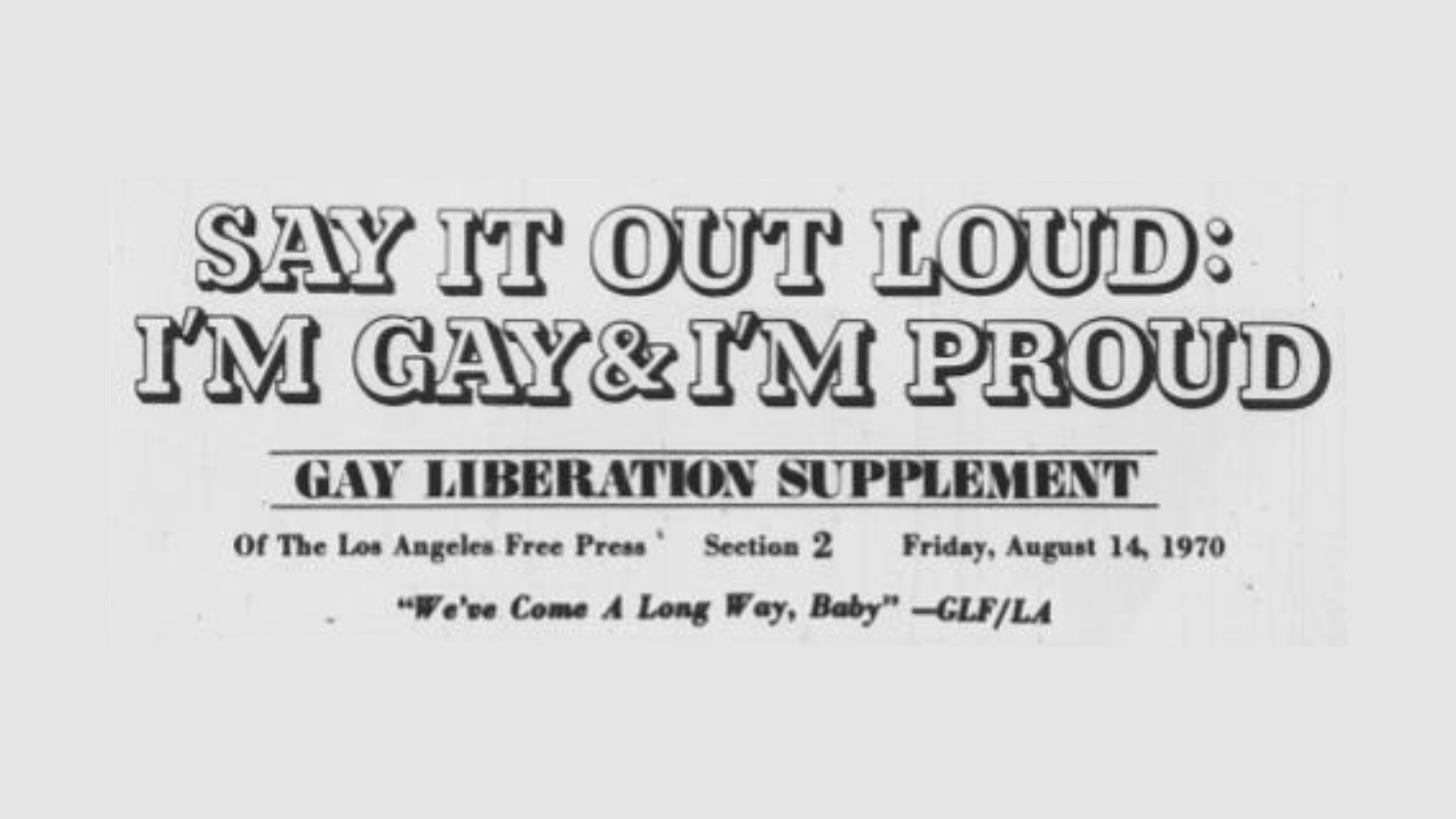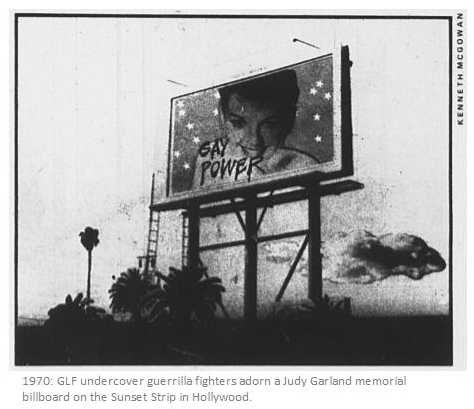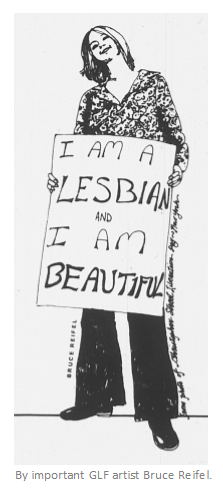
From January 1 until December 31, 1970, the pioneering Gay Liberation Front of Los Angeles had an office/meeting space for the first time at 577 ½ N. Vermont Ave. in East Hollywood. How that occurred and the importance of that space to the freedom of gay, lesbian, and trans people in L.A. are things I wrote about recently in an essay titled “Seeding a Gay Community in Los Angeles” that appeared in the laprogressive.com, The LGBTQ History Project, the LA Blade, WehoOnline.com. and other publications. [If anyone has photos of this building or office space, please contact me).
That liberated office space in East Hollywood was central to the rapid movement forward for Gay Liberation in L.A. I cordially invite you to return to 1970, like back to the future, and allow me to give you a historical tour of the L.A. GLF office then.
* * *
The tour begins. As you approach the old dowager of a fourplex building next to the freeway, there are four separate doors. When you open the second door on your left, you find well-worn wooden stairs to the second floor where there is a landing and a Gay Liberation poster of welcome.
As you turn to your left, there is a large, empty living room space with wooden floors. The south wall is anchored by a fireplace GLF never uses; hanging above the fireplace in a place of honor is an iconic poster of Huey Newton, the leader of the Black Panthers, sitting in a fancy wicker chair holding a rifle in his right hand and an African spear in his left hand. Flanking the fireplace and overlooking the Hollywood Freeway are two large, south facing windows that allow much natural light into the room.
Sitting on the north side of the room is a threadbare sofa on its last legs—the only furniture in the room. For the entirety of 1970, after 10 p.m. each day, that sofa and an old sleeping bag become my beloved bed.
At the east end of the north wall, a door leads into a small room with a large desk and a chair that the Peace and Freedom Party, the previous occupant, had left for us. Twenty-some battered folding chairs are stacked against the wall. They had been acquired from here and there. GLF had installed a telephone on the desk with a widely publicized GLF phone number. That telephone serves as an around-the-clock Gay Hotline, staffed during the day by GLF volunteers and at night by me. It keeps us busy with calls for dialogue and help from all over the country—the calls a catalogue of gay oppression and needs.

Outside the east wall is a sunroom filled with boxes. GLF does not have access to the sunroom. In a corner against the east wall of the living room are a neatly arranged row of about 30 picket signs saved from sundry demonstrations. GLF is prepared to go into direct action quickly with a picket line at a moment’s notice. For example, a call comes in on the Gay Hotline telling us that gay men are being arrested by the LAPD on the campus of Los Angeles City College, just blocks north of the GLF office. An hour later, GLF is in front of the college with a picket line protesting the arrests with LACC students enthusiastically joining in.
The west wall contains large, heavy, sliding wood doors that seal off GLF’s space from the living space behind them and always remain closed except when someone needs to use the bathroom.
The white walls are hung with anti-Vietnam War, Feminist, Chicano, Asian-American, Jewish, Black, First Nation, you-name-it movement posters and leaflets and quotes by revolutionary figures like Che Guevara and Malcolm X.
The small room is used as an office and the living room for our Sunday afternoon community/conscious-raising/business meetings and during the week
as a workspace. The Sunday meeting is attended by approximately 10-20 people, about 10 are core members who attend every week, the others come and go as the need be. The space is usually a beehive of activity. The tour ends.
* * *
In a recent interview by The LGBTQ History Project (1/11/24), Hiram Ruiz, who in 1970 was an undergraduate at Florida State University in Tallahassee, participated in a Sunday meeting at the GLF office. Here’s his report:
…I visited my grandfather in Los Angeles during spring break. I don’t remember how, but I heard about a meeting of the Gay Liberation Front in Los Angeles and went to that. It just blew me away. The energy and excitement were indescribable.
Ruiz went back to FSU inspired by what he encountered in L.A. and organized the GLF on campus there which spawned many such GLFs on campuses throughout the southeast U.S.
In 1970, many GLFs consisted of only a handful of people in major U.S. cities. The L.A. GLF made a concerted effort to maintain contact and solidarity with other GLFs and to birth new ones wherever and whenever possible. Many times, the birth of a new GLF just happened naturally when someone from out of town, like Ruiz, attended one of our Sunday afternoon meetings. Other times, it was more deliberately organized.

On June 27, 1970, the Saturday before the next day first L.A. Pride march on Hollywood Blvd. (then named Christopher St. West after the street location of the Stonewall Inn), initiated by GLF in New York City urging GLFs everywhere to celebrate the first anniversary of the Stonewall Uprising, L.A. GLF organized the “West Coast Gay Liberation Conference” at The Long March located adjacent to MacArthur Park. About 50 people, mostly gay men, attended. They came from San Diego, Santa Barbara, San Bernardino, San Francisco Bay area, Portland, Seattle, Phoenix, Albuquerque, Salt Lake City, and points in between. The conference focused on gay consciousness-raising, community organizing, and seeding new GLFs and creating cooperation and mutuality with those already existing. With the conference and march on Hollywood Blvd. that June weekend, an important cross-pollination of Gay Liberation in western U.S. was commencing.
That simple office in East Hollywood was all the space GLF needed at the time to organize the Gay Liberation movement in Los Angeles and beyond, fiercely fueled by the dharmic anger, resourcefulness, and exuberance of mostly under-35-year-old Gay Liberationists, smelling and creating their freedom.
It was from that simple GLF office in 1970, in the wake of the Stonewall Uprising, that plans were hatched that incited a radical Gay Liberation revolution of major proportions in Southern California. That revolution facilitated the emergence of a real gay and lesbian community in Los Angeles for the first time and birthed the L.A. LGBT Center (then called the Gay Community Services Center) to tend to the critical needs of that community. That revolution allowed gay and lesbian people to boldly seize their personal and societal liberation through joyous, radical self-acceptance instead of begging for acceptance from their oppressors. This seismic shift in consciousness was felt throughout the nation.
* * *
Don Kilhefner, Ph.D., in over 55 years as a gay community organizer, has been around the gay block more times than he can count, most of the time clothed.

Thank you for this, Dr. Kilhefner. I know the history of the Gay and Lesbian Front and the roots laid by you and Morris Knight and Harry Hay here (+ many others); I wish others in our community did too. We owe much to your bravery, tenacity and dedication to equality. As a community it seems we have lost our history, our connection to who came before us and how we got here. So many LGBTQ take their rights for granted. I hope that will change, especially in our current political climate where we are one step away from becoming… Read more »